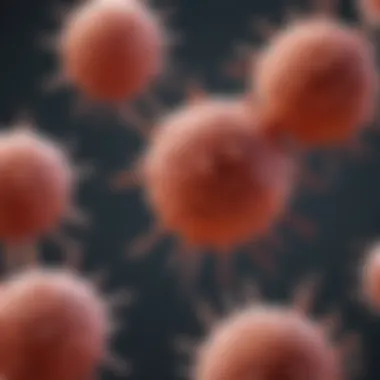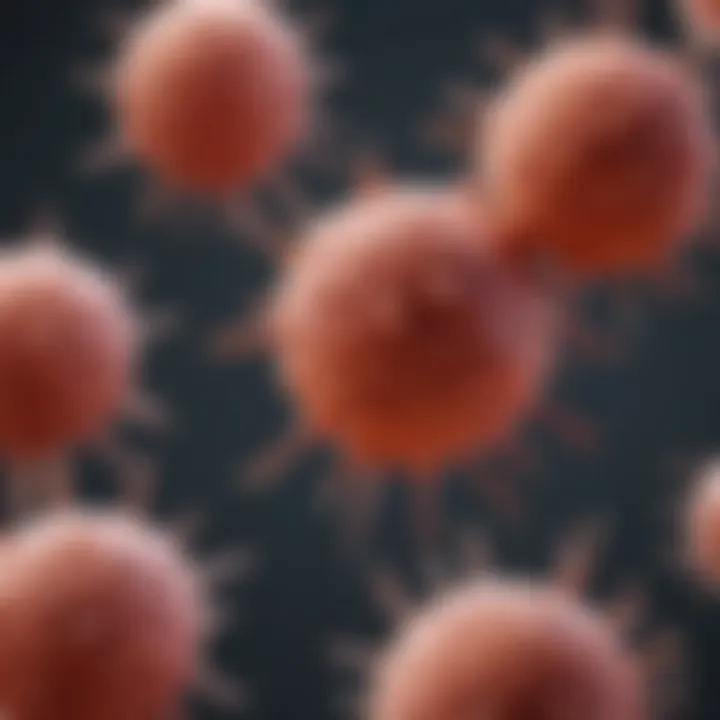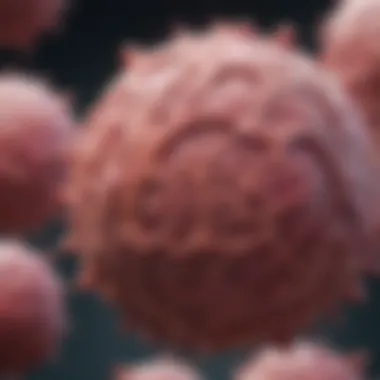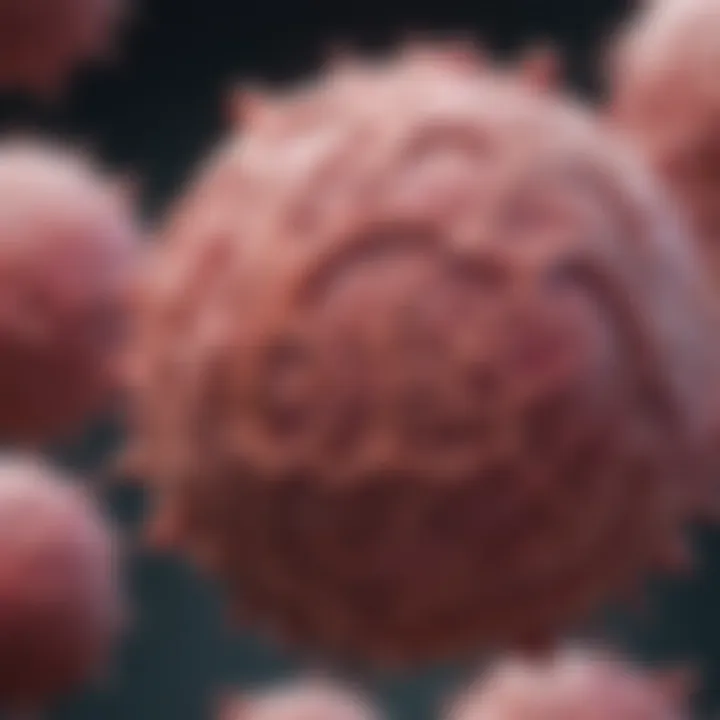Understanding Cancer Without Tumors: An In-Depth Exploration


Intro
Cancer is often viewed as a condition where tumors are present, leading to an association that can obscure the complexities of the disease. However, there are significant cases where cancer can manifest without traditional tumor formation. This exploration aims to demystify the interactions between cancer cells and their environments, highlighting how cancer can exist independently of solid masses. This understanding is crucial for students, researchers, and professionals in the field, as it opens avenues for diagnostic and treatment innovations.
Research Overview
Methodological Approaches
The investigation into cancer without tumors necessitates refined methodologies. Researchers employ various techniques, including high-resolution imaging, single-cell sequencing, and advanced biopsies. High-resolution imaging, for example, allows scientists to visualize cellular behaviors in real-time without requiring biopsies that might disrupt tissue integrity.
Single-cell sequencing provides insights into the genetic variations among cancer cells, highlighting how some cancers operate without forming masses. This approach aids in pinpointing specific characteristics of cancer cells, such as their adaptability and resistance to treatment.
Significance and Implications
Understanding cancer in the absence of tumors has profound implications. It challenges existing paradigms about cancer biology, emphasizing the necessity for broader approaches when diagnosing and treating these conditions. Given that many patients may not present with visible tumors, clinicians must be equipped to identify less obvious manifestations of the disease. The recognition of this phenomenon can lead to more personalized treatment strategies, ultimately improving patient outcomes.
Current Trends in Science
Innovative Techniques and Tools
Recent advancements in medical technology have catalyzed new research trajectories. Liquid biopsies, which analyze circulating tumor DNA, have emerged as pivotal tools for detecting cancer without physical tumors. This method not only enhances early detection but also facilitates real-time monitoring of treatment responses, allowing for adjustments based on individual patient needs.
Interdisciplinary Connections
The study of cancer without tumors highlights the importance of interdisciplinary collaboration. Insights from genetics, immunology, and bioinformatics converge to enrich the understanding of cancer biology. By integrating methodologies and knowledge from various fields, researchers can develop comprehensive approaches to address this complex issue.
"A tumor-less existence of cancer requires us to rethink how we approach diagnosis and therapies. The implications reach far beyond conventional oncology."
In summary, exploring cancer without tumors provides essential insights into this intricate disease. It emphasizes the need for constant evolution in research and clinical practices, steering the discourse toward more inclusive understandings of cancer.
Prelims to Cancer
The study of cancer is crucial in the field of medicine and human health. Understanding cancer, particularly in its form without tumors, allows researchers and healthcare professionals to broaden their perspective on how this disease operates. This article focuses on the complexities involved in types of cancer that do not result in tumor formation. By examining these forms closely, one can begin to appreciate the different biological behaviors and mechanisms that govern cancer development.
There are several reasons why exploring this topic is significant. First, it raises awareness about non-tumorous cancers such as leukemia and lymphoma, which do not manifest as solid masses. This knowledge can influence early detection strategies and treatment protocols. Second, it fosters a deeper understanding of cancer as a multifaceted disease, highlighting the importance of genetic and environmental factors in its pathogenesis. Lastly, the misconceptions surrounding cancer often stem from a limited view focused only on tumors, which may hinder the effectiveness of public health messaging and educational initiatives on cancer prevention and management.
Definition of Cancer
Cancer is defined as a collection of related diseases characterized by the uncontrolled growth and spread of abnormal cells in the body. These abnormal cells can invade and destroy healthy tissue, leading to severe health consequences. While traditionally viewed through the lens of tumor formation, it is essential to recognize that cancer can exist in forms that do not produce solid masses.
This aberrant growth often stems from mutations in the DNA of cells, which can be caused by various factors including environmental influences, lifestyle choices, and hereditary predispositions. Understanding this definition is the first step in grasping the complexities surrounding cancer, its diagnostics, and treatment options.
Overview of Tumors
Tumors are typically regarded as the most recognizable manifestation of cancer. They are classified into two main categories: benign and malignant. Benign tumors do not invade nearby tissues nor spread to other parts of the body, whereas malignant tumors are cancerous, exhibiting aggressive behavior and the potential for metastasis.
However, not all cancers present in this typical manner. For instance, blood cancers such as leukemia arise from the bone marrow and manifest systemically, rather than as a localized tumor. Similarly, cancers like multiple myeloma and lymphoma occur without distinct solid masses. Recognizing these variations is essential for a comprehensive understanding of cancer in its entirety.
"Cancer is not merely defined by the presence of a tumor but by the intricate processes that occur within the body at the cellular level."
Awareness of non-tumorous cancers challenges preconceived notions about cancer and stresses the importance of broader research and discussions within the medical community. This allows for an improved approach to understanding, diagnosing, and treating various forms of the disease.
Types of Cancer Without Tumors
Recognizing the types of cancer that can manifest without the presence of traditional tumors is crucial for understanding the diverse nature of cancer. This section addresses significant types, such as leukemia, lymphoma, multiple myeloma, and carcinomatosis. Each of these categories presents unique challenges and implications for diagnosis and treatment. Notably, exploring these cancers deepens our understanding of cancer biology and highlights the complexity of cellular changes that occur. It also serves to inform medical professionals and researchers about appropriate management strategies to address these conditions.
Leukemia and Lymphoma
Leukemia is a type of cancer that affects the blood and bone marrow, characterized by the overproduction of abnormal white blood cells. This proliferation disrupts normal blood function and can inhibit the formation of healthy blood cells. Unlike solid tumors, leukemia does not form a mass; rather, it is a systemic disease. On the other hand, lymphoma affects the lymphatic system, which plays a pivotal role in the immune response. Similar to leukemia, lymphoma can present as a widespread condition without a detectable tumor.
Individuals with leukemia often exhibit symptoms like fatigue, fever, and frequent infections, reflecting the compromised immune system caused by the abnormal cell count. Lymphoma may present with swollen lymph nodes, night sweats, or unexplained weight loss.
Both conditions are classified into various subtypes, which can affect treatment plans significantly. The treatment for leukemia often involves chemotherapy, targeted therapy, or even stem cell transplants, while lymphoma management may include radiation therapy along with chemotherapy.
Multiple Myeloma
Multiple myeloma is another form of cancer that occurs without the development of tumors. This cancer originates in the plasma cells, which are a type of white blood cell responsible for antibody production. In multiple myeloma, these plasma cells become malignant and proliferate in the bone marrow, leading to disruptions in normal blood function.


As the cancer progresses, it can cause bone pain, increased susceptibility to infections, and damage to the kidneys. Its systemic nature makes multiple myeloma particularly challenging to diagnose early since symptoms can be mistaken for other conditions.
Treatment options for multiple myeloma typically involve chemotherapy, immunomodulatory drugs, and novel therapies such as proteasome inhibitors. These treatments aim to manage symptoms and prolong survival while enhancing the patient’s quality of life.
Carcinomatosis
Carcinomatosis is characterized by the widespread distribution of malignant cells throughout the body. Unlike localized cancers, it can occur secondary to various primary cancers, such as breast, lung, or gastrointestinal cancers. This condition complicates the treatment as the cancerous cells may infiltrate multiple organs, affecting their function and necessitating a palliative approach early on.
Patients with carcinomatosis typically face significant challenges, with symptoms varying widely based on which organs are affected. Common symptoms include abdominal pain, nausea, and changes in bowel habits. Understanding the breadth of carcinomatosis is essential for forming effective treatment plans aimed at alleviating discomfort and improving functional capacity.
In summary, the emphasis on types of cancer without tumors sheds light on distinct forms of malignancy that pose unique challenges for diagnosis and treatment. By addressing leukemia, lymphoma, multiple myeloma, and carcinomatosis, we gain a deeper appreciation for the complexities of these diseases and underscore the importance of ongoing research and awareness.
Mechanisms of Tumor-less Cancer
Understanding the mechanisms behind tumor-less cancers is essential for appreciating the broader spectrum of this type of cancer. These cancers, while lacking typical tumor formations, still operate through complex biological processes. Their study illuminates how cancer can manifest in different forms, presenting unique challenges for diagnosis and treatment. Knowing these mechanisms helps researchers and clinicians better strategize cancer management. This section will explore both cellular mechanisms and genetic mutations that define tumor-less cancers.
Cellular Mechanisms
Cellular mechanisms in cancer often focus on the processes that enable abnormal cell function and proliferation. In the context of tumor-less cancers, this includes the way these cells interact with their environment and other cells. There are several key aspects to consider:
- Cell Communication: Cancer cells often communicate differently than normal cells. They may release signals that promote inflammation or alter the behavior of surrounding cells, enabling them to thrive without a solid tumor.
- Immune Evasion: Many non-tumorous cancers utilize strategies to evade detection by the immune system. They can modify their surface proteins or produce immune-suppressive substances, making it harder for the body to fight them off.
- Cell Cycle Dysregulation: The regulation of the cell cycle is often disrupted in cancers. Cells may bypass the checkpoints that normally prevent damaged or abnormal cells from dividing. This uncontrolled proliferation can occur without forming a mass, particularly in blood cancers like leukemia.
Understanding these cellular interactions is crucial. Specific therapeutic approaches, targeted therapies, may be more effective when these dynamics are clearly understood. By knowing how cancer cells behave on a cellular level, treatments can be designed to re-engage the immune system or target specific signaling pathways effectively.
Genetic Mutations
Genetic mutations serve as the foundation for the development of tumor-less cancers. These mutations can vary and lead to different types of cellular behavior. It's important to note the following aspects:
- Oncogenes and Tumor Suppressor Genes: Mutations can activate oncogenes, which promote cell growth and division, while simultaneously inactivating tumor suppressor genes, which normally function to limit cell proliferation. This dual mechanism is crucial in non-tumorous cancers, as even small changes can significantly impact cell behavior.
- Clonal Evolution: cancer cells can undergo mutations over time, leading to populations of cells that may vary in their characteristics. This evolution can lead to resistance against treatments, making it more difficult to manage effectively.
- Epigenetic Factors: Beyond simple genetic mutations, epigenetic changes can alter gene expression without changing the DNA sequence itself. Such changes can also result in cancerous behavior in cells, contributing to various forms of cancer without a tumor.
Addressing genetic mutations in tumor-less cancers is critical for developing personalized medicine strategies. By understanding the specific mutations present in a patient's cancer, targeted therapies can be deployed more effectively, improving treatment efficacy.
"Genetic mutations offer a window into the unique biology of cancers. Their study is essential in devising effective treatments and understanding individual variability in response to therapy."
This detailed understanding of mechanisms forms a basis for further research and clinical strategies, demonstrating the importance of continued exploration in this area of oncology.
Diagnosis of Non-Tumorous Cancer Forms
Understanding the diagnosis of non-tumorous cancer is crucial for various reasons. First, many cancers can exist without producing solid tumors, which can complicate the diagnostic process. For healthcare professionals, distinguishing these types of cancer requires deep knowledge of the unique markers and symptoms associated with them. Second, accurate diagnosis can significantly influence treatment strategies and prognoses, guiding decisions that impact patient outcomes. Finally, there is a need to increase awareness among researchers and healthcare practitioners about the diagnostic challenges and the tools available for detecting cancers without tumors.
Diagnostic Imaging Techniques
Diagnostic imaging plays an essential role in identifying non-tumorous cancer forms. Traditional imaging techniques, like X-rays and CT scans, may not always detect these cancers, particularly since they do not present as structural anomalies. However, advanced methodologies such as MRI and PET scans can provide insights into metabolic processes and tissue characteristics.
- Magnetic Resonance Imaging (MRI) can be particularly effective in examining soft tissues and looking for abnormal changes that suggest cancer activity. As it does not rely on ionizing radiation, it is a safer option for repeated evaluations.
- Positron Emission Tomography (PET) scans provide valuable information about cellular activity. These scans can highlight areas of increased glucose metabolism, a marker often associated with malignant growth.
- Ultrasound imaging can also assist in observing abnormal fluid collections or lymphatic enlargement, which can be indicative of conditions like leukemia or lymphoma.
Combining these imaging techniques with a comprehensive patient history enhances diagnostic accuracy. It's important for clinicians to remain vigilant and consider non-tumor-related cancers when interpreting results.
Blood Tests and Biomarkers
Blood tests are indispensable for diagnosing non-tumor cancers. Unlike conventional tumors, these cancers often leave molecular traces in the bloodstream. Biomarkers can offer insights into the presence and progression of diseases like leukemia or multiple myeloma.
- Complete Blood Count (CBC) provides a starting point, revealing abnormal levels of white blood cells, red blood cells, or platelets that may indicate underlying cancers.
- Specific biomarkers such as the presence of prostate-specific antigen (PSA), calcitonin, or beta-2-microglobulin can signal particular types of cancers.
- Flow cytometry and PCR tests are advanced testing methods that identify particular cell populations or genetic mutations, which can confirm stylizing non-tumor cancers.
Accurate diagnosis through blood tests not only aids in identifying cancers without tumors but also helps in determining the most effective treatment plans.
Treatment Options for Tumor-less Cancers
Treatment options for tumor-less cancers represent a distinct field of oncology. These cancers present unique challenges that require tailored approaches. Understanding these treatment options is critical because they directly impact survival rates and quality of life. As tumor-less cancers do not exhibit the physical masses typically associated with tumors, their treatment strategies must adapt accordingly. This section will outline specific methods, emphasizing the importance of individualized care.
Chemotherapy Protocols
Chemotherapy plays a significant role in treating various types of tumor-less cancers like leukemia and lymphoma. This systemic treatment helps to kill or slow the growth of cancer cells. It is essential to use precise protocols to target the specific type of cancer being treated.
- Mechanism of Action: Chemotherapy disrupts the cell cycle, targeting rapidly dividing cells. This is effective in conditions where cancer spreads through the bloodstream rather than forming discrete masses.
- Protocol Customization: Treatment regimens are often tailored based on the patient's cancer type, stage, and overall health. Factors like age and previous health conditions significantly influence the choice of drugs and dosage.
- Side Effects Management: Common side effects include nausea, fatigue, and susceptibility to infections. Oncologists focus on minimizing these effects, enhancing patient comfort during treatment.
"Personalized chemotherapy plans are essential for effectively managing tumor-less cancers, as they account for the unique biology of each patient's condition."
- Monitoring and Adjustment: Regular blood tests and assessments are crucial. They help oncologists monitor the effectiveness of chemotherapy and make necessary adjustments.


Immunotherapy Approaches
Immunotherapy represents an innovative treatment option for tumor-less cancers. This type of therapy enhances the body’s immune system to fight cancer more effectively.
- Types of Immunotherapy: There are various forms of immunotherapy, including checkpoint inhibitors and CAR T-cell therapy. These methods have shown promise for cancers that do not form tumors, such as certain leukemias.
- Mechanism of Action: By targeting specific molecules on immune cells or tumor cells, immunotherapy can help the body recognize and attack cancer cells. This strategy is particularly useful because tumor-less cancers often evade the immune system.
- Research and Development: Ongoing trials are exploring new immunotherapy options. Researchers aim to improve efficacy and reduce side effects, expanding the applicability of immunotherapy in tumor-less cancers.
- Challenges: Despite its potential, immunotherapy is not suitable for all patients. Factors like genetic mutations and the specific microenvironment of the cancer influence its success. Patients may need comprehensive assessments before starting treatment.
Prognosis and Outcomes
The topic of prognosis and outcomes in cancer without tumors is critical. A proper understanding of prognosis helps patients, families, and healthcare providers navigate the complexities of this condition. Without the standard structure of solid tumors, prognosis can be uncertain, making it essential to explore survival rates and other variables affecting patient outcomes.
Survival Rates
Survival rates for non-tumorous cancers can vary significantly depending on the type, stage at diagnosis, and response to treatment. Unlike solid tumors where staging often defines prognosis, non-tumorous cancers may lack clear staging criteria. For instance, leukemia's prognosis often hinges on factors like cell type and genetic mutations rather than the presence of a tumor.
- Acute Lymphoblastic Leukemia (ALL) has a relatively high survival rate, often exceeding 85% in children, but lower in adults.
- Chronic Myeloid Leukemia (CML) has improved survival outcomes due to targeted therapies like Imatinib.
- Multiple Myeloma, while not curable, shows median survival extending beyond five years with treatment developments.
It is also crucial to understand that statistics are not absolute. They serve as guides rather than determinants. Each individual’s outcome may differ based on unique biological factors.
Quality of Life Considerations
Quality of life (QoL) takes precedence in caring for patients with cancer without tumors. These cancers often lead to systemic manifestations that can affect physical and emotional well-being. Patients may face challenges related to symptoms, treatment side effects, and the psychological burden of their diagnosis.
- Physical Symptoms: Fatigue, pain, and other systemic symptoms can drastically alter daily functioning.
- Emotional Health: The absence of a palpable tumor may lead to uncertainty, leading to increased anxiety or depression.
- Support Systems: Having strong emotional and social support is essential. This may include counseling, joining support groups, or engaging with healthcare providers regularly.
"Understanding and addressing quality of life is not ancillary; it is a central part of managing cancer without solid tumors."
As with survival rates, quality of life metrics can differ from patient to patient. Regular assessments can identify areas needing attention, allowing for a more tailored approach to care. Ultimately, the goal is to maintain or improve quality of life, which holds significant value in the overall treatment experience.
Prevention and Risk Factors
Understanding how to prevent cancers that do not involve the formation of tumors is crucial in the broader scope of cancer biology. Awareness of specific risk factors can lead to early interventions and better health outcomes. The concept of prevention in this context extends beyond avoiding known carcinogens. It encompasses a multi-faceted approach that includes lifestyle changes, regular screenings, and addressing both environmental and genetic elements.
Environmental Influences
Environmental factors play a significant role in the development of non-tumorous cancers. These factors range from exposure to pollutants to lifestyle choices.
- Pollution and Chemicals: Air pollution, for example, has been linked to the exacerbation of leukemia. Additionally, exposure to industrial chemicals, such as benzene, can increase the risk of developing blood cancers. In some regions, water quality and contaminants pose serious health risks.
- Radiation Exposure: Ionizing radiation can lead to genetic damage that contributes to cancers like leukemia. Understanding the sources of potential radiation exposure is important.
- Lifestyle Choices: Choices such as smoking and excessive alcohol consumption are known carcinogens. Avoiding tobacco, in particular, is a proven method to reduce the risk of certain blood cancers.
By adopting healthier habits and being mindful of environmental exposure, individuals can significantly lower their risk of these cancers. Regular monitoring and community awareness about local environmental hazards also contribute positively to prevention efforts.
Genetic Predisposition
Genetic factors are equally as important as environmental influences in understanding cancer risk. Some individuals may possess hereditary mutations that predispose them to specific types of cancer, including those without tumors.
- Family History: A family history of certain cancers, such as leukemia, can alert individuals to their potential risk. Genetic counseling may help assess these risks.
- Inherited Mutations: Genetic mutations in genes like BRCA1 and BRCA2 are often discussed in relation to breast and ovarian cancer; however, they can indicate broader risks that affect other cancer types. Research is ongoing to determine new genetic links in non-tumorous cancers.
- Screening and Testing: Advances in genetic testing can identify markers that indicate a higher risk for non-tumorous cancers. Regular screening may enable earlier detection and management of conditions that could develop into cancer.
The integration of understanding environmental influences with genetic predisposition presents a comprehensive picture of cancer risk. Fostering a proactive approach to monitoring and prevention ensures greater health management and awareness among individuals and communities.
"Preventive measures targeting risk factors can lead to potentially life-saving interventions in the battle against cancer."
By being informed and vigilant, individuals can navigate the complexities of cancer risk and take active steps towards prevention.
Controversies and Misconceptions
The discussion of cancer without tumors involves various controversies and misconceptions that can mislead patients and even professionals. Understanding these facets is vital for clear communication within the medical community and beyond. Incorrect beliefs can impact diagnosis, treatment choices, and even emotional well-being.
Misunderstandings related to non-tumorous cancers can lead to stigmatization, confusion about treatment options, and inadequate patient support. Addressing these issues offers benefits such as enhanced patient education, better research focus, and supportive care aligned with specific needs.
Common Myths About Tumors
Several common myths exist that link cancer solely to the presence of tumors. One prevalent myth is that all cancers result in tumor formation. However, this is not accurate. Conditions like leukemia and multiple myeloma arise without solid tumors, illustrating that cancer can manifest in different forms. This misconception can lead to false assumptions about diagnoses and limit understanding of these conditions.
Another frequent myth is the belief that tumor size or presence determines cancer severity. This can misguide patients into thinking that small tumors are always less concerning than cancers without tumors. In reality, non-tumorous cancers can be very aggressive and require immediate attention.
It’s crucial to demystify these misconceptions by providing clear educational resources and correct information to foster a more accurate understanding of different cancer types.
Understanding Cancer Terminology
A significant part of the confusion around cancer stems from the terminology used in the medical field. Terms like “malignant,” “tumor,” and “carcinoma” can create ambiguity, particularly for those not trained in medical jargon.


For instance, the term malignant is often equated only with tumor presence. However, it can also refer to aggressive forms of cancer that do not form a primary solid mass, like certain leukemias. Clarity in cancer terminology ensures better comprehension among patients and their families, promoting informed discussions with healthcare providers.
Understanding specific terms can facilitate awareness around various cancers, uncovering their implications. Efforts must focus on redefining and explaining these terms to bridge the knowledge gap between health professionals and those affected by cancer.
"Understanding when terminology goes wrong can shift the entire perspective on a cancer diagnosis."
In summary, the controversies and misconceptions surrounding cancer, especially those without tumors, underscore the necessity for precise education and clear communication. Addressing these issues can lead to improved patient experiences and better treatment outcomes.
Living with Non-Tumorous Cancers
Understanding the experience of living with non-tumorous cancers is vital. These forms of cancer, such as leukemia or multiple myeloma, often introduce unique challenges. Affected individuals may not face the same physical manifestations as those with tumors. However, the psychological and emotional weight can be significant. Knowledge about these cancers helps inform the support systems needed and fosters resilience among patients.
Additionally, it can empower patients to manage their condition proactively. This section looks into crucial aspects like available support systems and mental health considerations. These elements offer a valuable framework for coping with the nuances of life with non-tumorous cancers, emphasizing the need for holistic care.
Support Systems
Support systems play a critical role in the lives of people battling non-tumorous cancers. Family, friends, and healthcare providers form the bedrock of this network. These individuals can offer emotional support, practical assistance, and companionship during treatment journeys. Additionally, peer support groups can also provide a sense of community. These groups allow patients to connect with others facing similar challenges, thus sharing experiences and advice.
Moreover, professional counseling services can be invaluable. Such experts can guide individuals through their emotional struggles, offering coping mechanisms tailored to their unique situations.
- Family Involvement: Family can help navigate treatments and provide emotional care.
- Peer Support: Engaging with others who understand the journey can lessen feelings of isolation.
- Professional Counseling: Trained therapists can assist in managing anxiety or depression.
"Support is a crucial pillar that can enhance resilience and overall well-being of cancer patients."
These elements, together, can create a well-rounded support system that nurtures one’s overall health.
Mental Health Considerations
Mental health is profoundly impacted when living with non-tumorous cancers. The absence of visible tumors does not lessen the psychological burden. Patients often experience anxiety about their condition, treatment, and potential outcomes. Recognizing this emotional aspect is essential for both patients and caregivers.
Mental health challenges can manifest in various ways, including depression, fear, or stress. Understanding these possible feelings allows for better communication and coping strategies. Regular mental health check-ins can facilitate access to necessary resources.
- Anxiety Management: Techniques such as mindfulness or meditation can aid in reducing anxiety levels.
- Regular Counseling: Ongoing therapy sessions can help address sudden emotional shifts.
- Community Activities: Engaging in group activities can help create social connections and reduces feelings of isolation.
Overall, emphasizing mental health not only addresses their emotional needs but also contributes positively to recovery and quality of life.
Future Research Directions
Research into cancer without tumors is vital for advancing our comprehension of this intricate disease. As more individuals diagnosed with cancer may not exhibit traditional solid masses, understanding these cancer forms can direct medical focus and resources more effectively. This section discusses key advancements and breakthroughs in research that could alter the landscape of cancer treatment and management.
Advancements in Research
Recent progress in cancer research without tumors highlights the increasing recognition of the biological complexity of these diseases. Scientists focus on at least a few critical areas:
- Genomics: Next-generation sequencing technologies have given rise to insights into the genetic mutations associated with cancers that lack tumors. The capability to analyze vast amounts of genetic data allows for the identification of new biomarkers and potential therapeutic targets.
- Liquid Biopsies: Innovations in liquid biopsy techniques enable the detection of circulating tumor DNA and other molecular markers in blood samples. This development is particularly relevant for cancers like leukemia and lymphoma, where solid tumors are not present.
- Biological Pathways: Understanding cellular signaling pathways that promote cancer without the presence of tumors has become crucial. This focus may lead to targeted therapies that intercept these pathways.
Emerging technologies in these areas could refine diagnostic and therapeutic strategies for non-tumorous cancers, enhancing outcomes and survival rates for patients.
Potential Breakthroughs
The future of research in non-tumorous cancers holds promise for significant breakthroughs. Some areas to watch include:
- Immunotherapy Developments: As research continues to improve our understanding of immune system interactions with cancer cells, we may see innovative immunotherapeutic approaches tailored specifically for tumor-less cancer. This could transform treatment paradigms.
- Personalized Medicine: Advances in data analytics and artificial intelligence might enable more personalized treatment plans. Tailoring therapies to an individual's specific genetic and molecular profile could lead to enhanced efficacy and reduced side effects.
- Gene Editing Techniques: Technologies like CRISPR/Cas9 hold the potential to revolutionize cancer treatment. Targeted gene editing could correct mutations or modulate gene expression, offering new avenues for intervention in non-tumorous cancers.
The potential for breakthroughs in the understanding and treatment of non-tumorous cancers is vast. It requires a commitment to interdisciplinary collaboration and innovative thinking.
The landscape of cancer research is ever-evolving. As we build knowledge, the implications for treatment and patient outcomes become clearer. Continued focus on non-tumorous cancers will likely uncover additional complexities, pathways, and solutions that remain unknown today.
Closure
The concluding section of this article emphasizes the significance of understanding cancers that do not produce tumors. This exploration broadens our perception of cancer, highlighting a complex biological reality where cancer can manifest without the formation of solid masses. It challenges conventional notions and encourages deeper inquiry into cancer biology, which is crucial for researchers, students, and healthcare professionals.
Recap of Key Points
In summarizing the article, we can outline the following critical points:
- Types of Non-Tumorous Cancers: We discussed unique forms of cancer such as leukemia, lymphoma, multiple myeloma, and carcinomatosis, illustrating how these conditions operate without traditional tumors.
- Mechanisms Involved: Cellular mechanisms and genetic mutations play pivotal roles. Unraveling these processes offers insight into how cancer can thrive even in the absence of tumors.
- Diagnosis Methods: Diagnostic techniques, including imaging and blood tests, are vital for identifying these non-tumorous cancers. This aspect is fundamental for early detection and treatment planning.
- Treatment Options: Various options, such as chemotherapy and immunotherapy, are applied to manage these cancers effectively.
- Prognosis: Factors influencing survival rates and quality of life considerations are paramount for patient care.
- Future Directions: Ongoing research is crucial for advancing our understanding and treatment of tumor-less cancers, potentially leading to innovative breakthroughs.
Final Thoughts on Cancer Without Tumors
In closing, recognizing and understanding cancer without tumors is essential for modern oncology. This knowledge impacts not just treatment approaches but also the support systems available for affected individuals. As cancer research progresses, embracing the diversity of cancer manifestations enriches our medical knowledge and improves therapeutic outcomes. For those living with non-tumorous cancers, understanding their condition can empower them to make informed decisions about their health. As we move forward, continued research and awareness will be necessary to demystify these cancer forms and enhance care quality.
"The complexity of cancer underscores the need for a multifaceted approach, considering both tumor and non-tumor based forms."
By remaining aware of and educated about these unique cancers, we can foster a more informed and compassionate healthcare environment.



